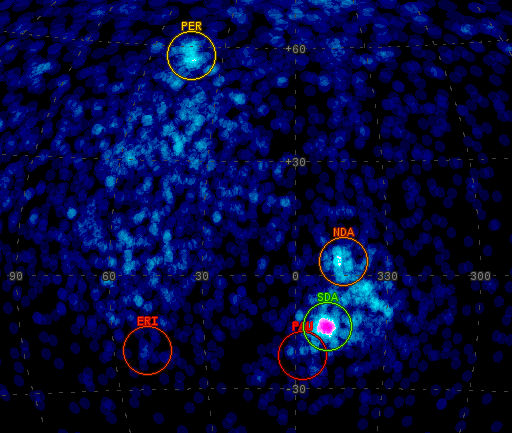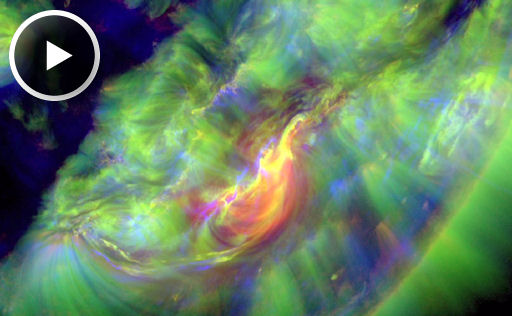Metallic photos of the sun by renowned photographer Greg Piepol bring together the best of art and science. Buy one or a whole set. They make a stellar gift. | | |
THE PERSEID METEOR SHOWER IS UNDERWAY: Earth is entering a stream of debris from Comet Swift-Tuttle, source of the annual Perseid meteor shower. Worldwide observers are now reporting more than 30 Perseids per hour, a number that could triple during the weekend when Earth reaches the heart of the debris zone. Forecasters recommend looking during the dark hours before dawn, especially Sunday morning, August 12th, when activity is expected to be highest.
Got clouds? Tune into SpaceWeather Radio for live echoes from Perseid meteors flying over the US Space Surveillance Radar in Texas.
The multi-station Canadian Meteor Orbit Radar, sponsored by NASA's Meteoroid Environment Office, is also monitoring the Perseids. Live data are available here. Bright spots in this sample radar sky map show the radiants of currently active showers:

Clearly, the Perseids are not the only meteors in the sky this weekend. The Northern and Southern Delta Aquarids (NDA and SDA) are also active. These showers, which are minor compared to the Perseids, spring from 96P/Machholz, a comet that some researchers suspect is a visitor from another star system.
This is a great weekend for watching meteors--but that's not all. Venus, Jupiter and the crescent Moon are lining up in the pre-dawn sky right in the middle of the Perseid display. The conjunction of planets guarantees that you will see something beautiful even in the unlikely event that the shower fizzles. Sky maps: Aug. 11, 12, 13.
Realtime Perseid Photo Gallery
M-CLASS SOLAR FLARE: Sunspot AR1540 erupted on August 11th, producing a long-duration M1-class solar flare that peaked around 1220 UT. NASA's Solar Dynamics Observatory recorded the extreme ultraviolet flash:

The explosion hurled a faint cloud of plasma into space. Judging from the blast site's off-center location on the solar disk, the cloud is probably not heading for Earth. This conclusion is uncertain, however. Stay tuned for additional analysis. Solar Flare alerts: text, phone.
Realtime Space Weather Photo Gallery
Realtime Noctilucent Cloud Photo Gallery
[previous years: 2003, 2004, 2005, 2006, 2007, 2008, 2009, 2011]
Potentially Hazardous Asteroids (
PHAs) are space rocks larger than approximately 100m that can come closer to Earth than 0.05 AU. None of the known PHAs is on a collision course with our planet, although astronomers are finding
new ones all the time.
On August 11, 2012 there were potentially hazardous asteroids.
Notes: LD means "Lunar Distance." 1 LD = 384,401 km, the distance between Earth and the Moon. 1 LD also equals 0.00256 AU. MAG is the visual magnitude of the asteroid on the date of closest approach. | | The official U.S. government space weather bureau |
| | The first place to look for information about sundogs, pillars, rainbows and related phenomena. |
| | Researchers call it a "Hubble for the sun." SDO is the most advanced solar observatory ever. |
| | 3D views of the sun from NASA's Solar and Terrestrial Relations Observatory |
| | Realtime and archival images of the Sun from SOHO. |
| | from the NOAA Space Environment Center |
| | the underlying science of space weather |

